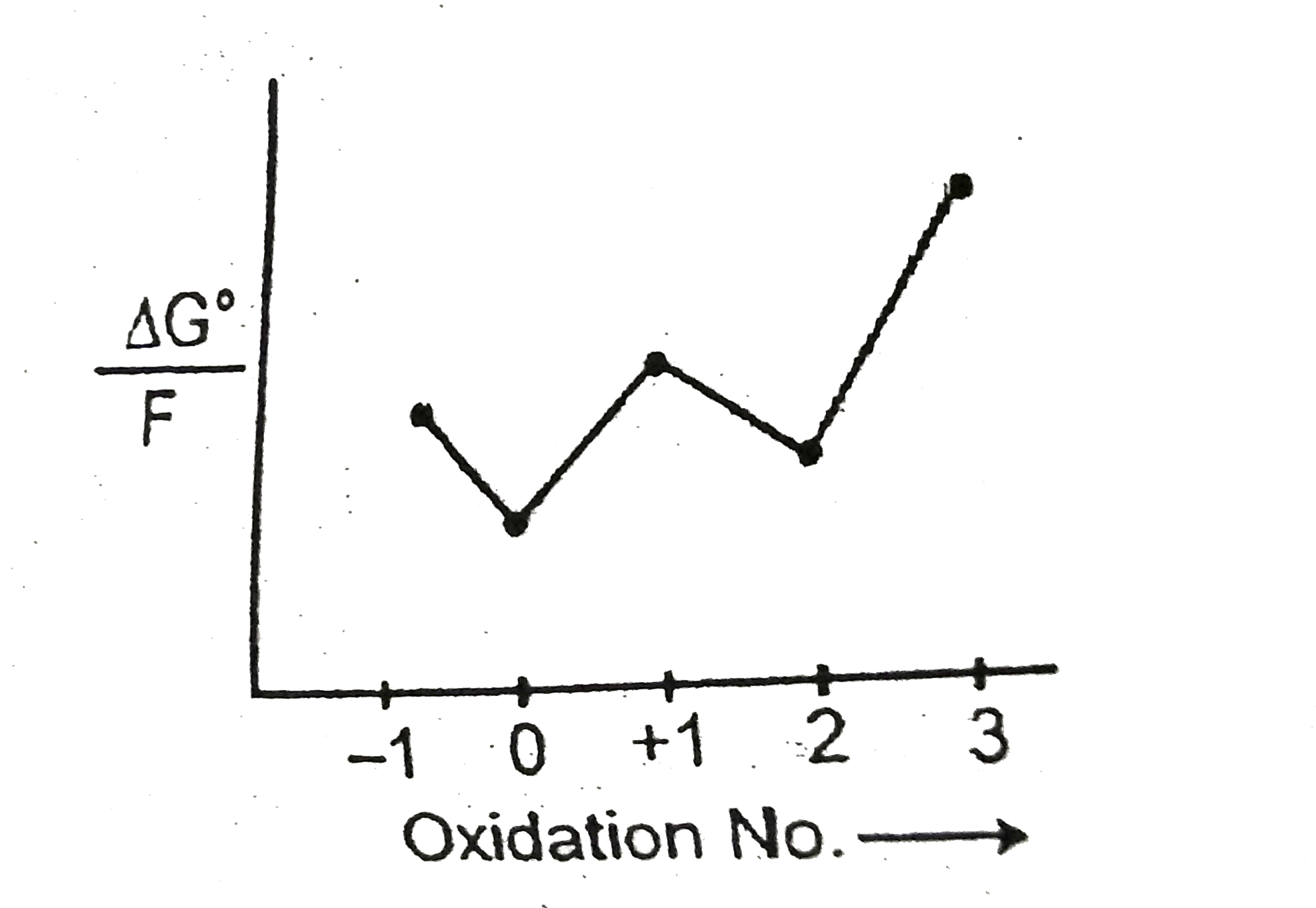If an element can exist in several oxidation states, it is convernient to display the reduction potentials correspondingg to the various half reactions in diagrammatic form, know as latimer diagram the latimer diagram for chlorine in acid solutio is
CIO−4+1.20V−−−−→CiO−3+1.18V−−−−→HClO2+1.60V−−−−→HClO1.67V−−→Cl21.36V−−→Cl− in basic solution.
ClO−40.37V−−→ClO−30.30V−−→ClO−20.68V−−→ClO−0.42V−−→Cl21.36V−−→Cl− The standard potentials for two nonadjacent species can also be calculateed by using the concept that △G∘ as an additive property but potential is not an additive property and △G∘=−nFx0. if a given oxidation stateis a stronger oxidising agent than the next higher oxidation state, disproportionation can occur. The reverse of disproportionation is called comproportionation. The relative stabilities of the oxidation state can also be understood by drawing a graph of △G∘/F against oxidation state, known as frost diagram, choosing the stability of zero oxidation state arbitrarily as zero. The most stable oxidation state of a species lies lowest in the diagram, disproportionation is spontaneous if the species lies above a straight line joining its two product species.
Q. What is the potential couple ClO−Cl− at pH=14?
1.78V
−0.94V
0.89V
−0.89V
The correct Answer is:C
To find the potential couple (ClO(−))/(Cl(−)) at pH=14, we can follow these steps:
Step 1: Identify the relevant half-reactions
From the Latimer diagram provided, we can identify the half-reactions involving ClO− and Cl−. The relevant half-reactions are:
1. ClO−(aq)+2e−→Cl−(aq)
Step 2: Determine the standard reduction potentials
From the Latimer diagram for basic solution, we have the following standard reduction potentials:
- ClO−(aq)→ClO−2(aq) with E0=0.68V
- ClO−2(aq)→ClO−3(aq) with E0=0.30V
- ClO−3(aq)→ClO−4(aq) with E0=0.37V
- ClO−(aq)→Cl−(aq) with E0=0.42V
- Cl−(aq)→Cl2(g) with E0=1.36V
Step 3: Calculate the potential for the couple (ClO−(aq))/(Cl−(aq))
Using the formula for calculating the potential of non-adjacent species:
E0=E01+E022
where E01 is the potential for ClO− and E02 is the potential for Cl−.
From the Latimer diagram:
- E0(ClO−)=0.42V
- E0(Cl−)=1.36V
Now, substitute these values into the formula:
E0=0.42+1.362=1.782=0.89V
Step 4: Conclusion
The potential couple (ClO−(aq))/(Cl−(aq)) at pH=14 is 0.89V.
Final Answer:
The potential couple (ClO−(aq))/(Cl−(aq)) at pH=14 is 0.89V.
---
From the Latimer diagram provided, we can identify the half-reactions involving ClO− and Cl−. The relevant half-reactions are:
1. ClO−(aq)+2e−→Cl−(aq)
From the Latimer diagram for basic solution, we have the following standard reduction potentials:
- ClO−(aq)→ClO−2(aq) with E0=0.68V
- ClO−2(aq)→ClO−3(aq) with E0=0.30V
- ClO−3(aq)→ClO−4(aq) with E0=0.37V
- ClO−(aq)→Cl−(aq) with E0=0.42V
- Cl−(aq)→Cl2(g) with E0=1.36V
Using the formula for calculating the potential of non-adjacent species:
E0=E01+E022
where E01 is the potential for ClO− and E02 is the potential for Cl−.
- E0(ClO−)=0.42V
- E0(Cl−)=1.36V
E0=0.42+1.362=1.782=0.89V
The potential couple (ClO−(aq))/(Cl−(aq)) at pH=14 is 0.89V.
The potential couple (ClO−(aq))/(Cl−(aq)) at pH=14 is 0.89V.
Topper's Solved these Questions
- BOOK - RESONANCE ENGLISHCHAPTER - ELECTROCHEMISRYEXERCISE - Exercise 37videos
ELECTROCHEMISRY
- BOOK - RESONANCE ENGLISHCHAPTER - ELECTROCHEMISRYEXERCISE - Part 223videos
ELECTROCHEMISRY
- BOOK - RESONANCE ENGLISHCHAPTER - ELECTROCHEMISRYEXERCISE - Objective Questions41videos
ELECTROCHEMISRY
- BOOK - RESONANCE ENGLISHCHAPTER - ELECTRO CHEMISTRYEXERCISE - PHYSICAL CHEMITRY (ELECTROCHEMISTRY)53videos
ELECTRO CHEMISTRY
- BOOK - RESONANCE ENGLISHCHAPTER - EQUIVALENT CONCEPT & TITRATIONSEXERCISE - Part -IV22videos
EQUIVALENT CONCEPT & TITRATIONS
Similar Questions
If an element can exist in several oxidation states, it is convernient to display the reduction potentials correspondingg to the various half reactions in diagrammatic form, know as latimer diagram the latimer diagram for chlorine in acid solutio is
CIO−4+1.20V−−−−→CiO−3+1.18V−−−−→HClO2+1.60V−−−−→HClO1.67V−−→Cl21.36V−−→Cl− in basic solution.
ClO−40.37V−−→ClO−30.30V−−→ClO−20.68V−−→ClO−0.42V−−→Cl21.36V−−→Cl− The standard potentials for two nonadjacent species can also be calculateed by using the concept that △G∘ as an additive property but potential is not an additive property and △G∘=−nFx0. if a given oxidation stateis a stronger oxidising agent than the next higher oxidation state, disproportionation can occur. The reverse of disproportionation is called comproportionation. The relative stabilities of the oxidation state can also be understood by drawing a graph of △G∘/F against oxidation state, known as frost diagram, choosing the stability of zero oxidation state arbitrarily as zero. The most stable oxidation state of a species lies lowest in the diagram, disproportionation is spontaneous if the species lies above a straight line joining its two product species.
Q. Which of the following statement is correct?View SolutionIf an element can exist in several oxidation states, it is convernient to display the reduction potentials correspondingg to the various half reactions in diagrammatic form, know as latimer diagram the latimer diagram for chlorine in acid solutio is
CIO−4+1.20V−−−−→CiO−3+1.18V−−−−→HClO2+1.60V−−−−→HClO1.67V−−→Cl21.36V−−→Cl− in basic solution.
ClO−40.37V−−→ClO−30.30V−−→ClO−20.68V−−→ClO−0.42V−−→Cl21.36V−−→Cl− The standard potentials for two nonadjacent species can also be calculateed by using the concept that △G∘ as an additive property but potential is not an additive property and △G∘=−nFx0. if a given oxidation stateis a stronger oxidising agent than the next higher oxidation state, disproportionation can occur. The reverse of disproportionation is called comproportionation. The relative stabilities of the oxidation state can also be understood by drawing a graph of △G∘/F against oxidation state, known as frost diagram, choosing the stability of zero oxidation state arbitrarily as zero. The most stable oxidation state of a species lies lowest in the diagram, disproportionation is spontaneous if the species lies above a straight line joining its two product species.
Q.
For a hypothetical element, the frost diagram is shown in figure.? which of the following oxidation state is least stable?View Solution
Knowledge Check
- Question 1 - Select One
Using the following Latimer diagram for bromine,
pH=0,BrO−41.82V−−→BrO−31.50V−−→HBrO1.595V−−−→Br21.06552V−−−−→Br−
the species undergoing disproportionation isABrO−4BBrO−3CHBrODBr2
Find out the compounds that will disproportionate in their aqueous solution.
(I)ClO−4overst(+0.36V)→ClO−3+0.33V−−−−→ClO2+0.66V−−−−→OCl−+0.40V−−−−→12Cl2+1.36−−−→Cl−
(II)MnO−4+0.56−−−→MnO2−4+2.22V−−−−→MnO2+0.95V−−−−→Mn3++1.55−−−→Mn2+(−0.19)V−−−−−−→MnView SolutionCH3−CH3∣CH−NO2NaNO2+H2SO4−−−−−−−−−−−−→at0∘C(A). (A) is:
View SolutionWhich H atom in the following ester is most acidic ?
1CH3−2CH2−O∣∣C−3CH2−O∣∣C−O−4CH25CH3View SolutionIn 1CH2=2CH−3CH2−4C≡5CH, the C2−C3 bond involves the hybridization of the type :
View SolutionArrange nucleophilicity of given species in decreasing order:
(1) CH3−өCH2
(2) CH3−өO
(3) өNH2
(4) өFView SolutionName the type of reactions for the following chemical equations.
2SO2+O2V2O5⇐⇒2SO3View SolutionGive IUPAC name for each of the following
H34C−O∣∣3C−2CH2−O∣∣1C−OHView Solution

